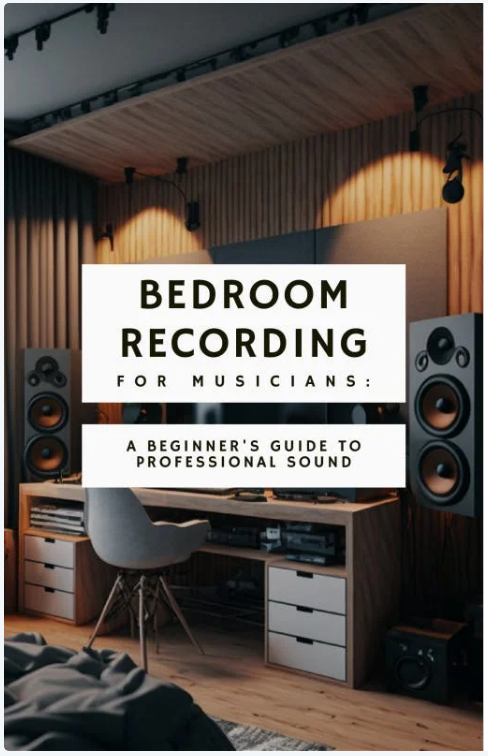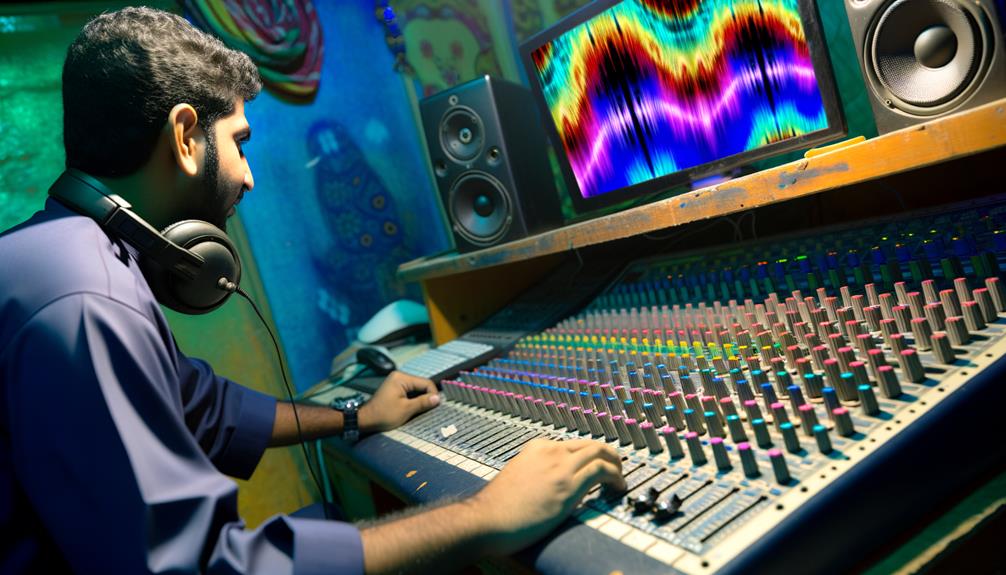As a mixing engineer in music production, your role is essential. You transform raw recordings into cohesive tracks, adjusting and balancing audio levels, while enhancing sound quality with effects. You’ll develop an acute ear for detail, master audio software, and guarantee consistency throughout. Alongside these technical skills, communication is key as you collaborate with artists and producers, bringing their vision to life. Exciting challenges await you in various work environments, from concert venues to home studios. Stick around, there’s a lot to learn about how you can navigate these challenges and deliver stunning audio experiences.
Career Path of a Mixing Engineer
Starting your journey as a mixing engineer typically involves beginning as an assistant engineer in a music studio, where you gain hands-on experience and learn the intricacies of the craft. This foundation allows you to grasp the fundamentals of mixing, from understanding the acoustics to operating sophisticated audio equipment. You’ll soon discover that this role is as much about science as it’s about art.
As you grow in confidence and expertise, you’ll likely progress to a full-fledged recording engineer role. This could mean branching out on your own, or securing an apprenticeship under an experienced mixing engineer. You might even find exciting opportunities in related fields such as mastering or producing.
Breaking into this field isn’t a walk in the park, but it’s worth it. You can secure full-time positions in studios, or opt for the flexibility of freelance work. Building your clientele through word of mouth, networking, and leveraging job listings for in-house positions can be fruitful strategies.
Essential Skills for Mixing Engineers
After setting your foot firmly on the career path, it’s essential to hone the specific skills that set successful mixing engineers apart. You’ll need to develop a keen ear for musical detail, a skill that helps you identify and correct imperfections. This, coupled with a deep understanding of sound theory and acoustics, will enable you to create mixes that resonate with the audience.
Familiarity with audio editing software and Digital Audio Workstations (DAWs) is a must-have. These tools are the bread and butter of your profession, helping you manipulate sound to your liking. Additionally, you’ll be expected to master the use of high-quality studio monitors, audio interfaces, and outboard gear.
Interpersonal skills are just as critical as technical ones. You must be able to communicate effectively with artists and producers, transforming their creative vision into a tangible product. The ability to work under pressure and adhere to tight deadlines is also essential.
Effective Mixing Techniques
Now, let’s immerse ourselves in some effective mixing techniques that can take your mixes to the next level. Remember, there’s no ‘one-size-fits-all’ approach; it’s about exploring and experimenting to find what works for you.
First off, EQ sweeps can be a great tool to identify and eliminate problematic frequencies. By boosting a narrow band and slowly sweeping it across the frequency spectrum, you’ll find those pesky areas that need attention. Don’t be scared to cut frequencies, as this can open up space and clarity in your mix.
Parallel compression is another innovative technique. It allows you to keep the dynamics of a track while adding power and thickness. By duplicating a track and heavily compressing the duplicate, you blend the compressed and uncompressed versions to create a fuller sound.
Lastly, think about using automation to add movement and interest to your mix. You can automate volume, panning, effects, and more. This technique lets you highlight certain elements at just the right moments, making your mix engaging and dynamic.
Dive in, experiment, and find your unique mixing style. Your mixes will thank you.
Balancing Audio in a Mix
Achieving a well-balanced audio mix is one of the most essential tasks you’ll tackle as a mixing engineer. You’re like a chef, crafting a sonic dish where all ingredients harmonize. Your goal is to make sure that each track, whether it’s vocals, guitar, or drums, finds its rightful place in the overall mix.
You’ll use tools like equalization to shape the tone of individual tracks, carving out space in the frequency spectrum. Compression then comes into play, controlling the dynamics of the sound and ensuring nothing is too loud or too soft.
You’ll also need to master the art of panning, an innovative technique that positions sound in the stereo field. This is where your creativity shines as you create a 3D soundscape, giving each element its own spatial location.
Gear and Equipment Usage
Once you’ve mastered the art of balancing audio, understanding the right gear and equipment becomes your next key step in the process.
The mixing console is your best ally, serving as the hub of your operations. From here, you’ll control and manipulate the various audio signals.
Software like ProTools or GarageBand, known as Digital Audio Workstations (DAWs), will become your virtual playground. They offer a myriad of tools for tweaking and perfecting a mix.
Software effect processors, samplers, and synthesizers also form part of your arsenal, allowing you to create or modify sounds for an innovative mix.
Hardware isn’t to be ignored. Synthesizers and theremins may seem old school, but they’re instrumental in achieving unique sounds. Incorporating these traditional tools with modern tech can give your mixes a distinctive edge.
Challenges in Mixing Engineering
As a mixing engineer, you’ll face a unique set of challenges, particularly when it comes to achieving a well-balanced mix. Each track you work on demands individual attention, with every instrument and vocal line needing to shine without overpowering the others. It’s a tricky balancing act.
Dealing with frequency conflicts between various sound sources is another hurdle. Identifying and resolving these conflicts while maintaining the integrity of the sound isn’t simple. You’ll need a keen ear and a deep understanding of sound theory to navigate this maze.
Then there’s the challenge of ensuring consistent audio quality across different playback systems. What sounds fantastic on your studio monitors mightn’t translate well to a car stereo or smartphone speaker. You’ll need to test your mixes on various systems to guarantee a consistent listening experience.
Meeting client expectations adds another layer of complexity. You’re the bridge between the artist’s vision and the technical realities of sound production. Balancing creativity with technical constraints often requires innovative solutions.
In this fast-evolving field, staying up-to-date with the latest audio technologies is vital, yet challenging. But remember, these challenges also drive growth and foster innovation in your craft.
Collaboration and Communication
While tackling these challenges in mixing engineering, you’ll find that effective collaboration and communication are key to your success. You see, a mixing engineer isn’t an island. You’re part of a larger team that includes artists, producers, and other engineers. To create a harmonious final product, you need to work seamlessly with these individuals.
Your task isn’t just to manipulate sound but also to translate the creative vision of artists into reality. It’s about turning musical ideas into audible experiences. To achieve this, you must foster open lines of communication, be receptive to feedback, and convey your technical insights in an accessible way.
Innovative collaboration tools like shared digital workspaces and cloud-based platforms can streamline this process. They allow real-time interaction and feedback, ensuring everyone is on the same page.
It’s also essential to embrace the unique perspectives and inputs of your team, fostering an environment of mutual respect and idea exchange.
Career Opportunities and Work Environment
In the world of mixing engineering, you’ll find a myriad of career opportunities in various work environments. You can start off as an assistant engineer in a recording studio, gradually honing your skills and climbing the ladder to become a full-fledged mixing engineer. Alternatively, you can apprentice under an experienced engineer, absorbing their knowledge and techniques.
You’ll also find opportunities in related fields such as mastering and producing. If you’ve got a taste for the live, adrenaline-fueled atmosphere of concerts, you could work as a live sound engineer at music events. If the glitz and glamour of Hollywood beckons, the film industry also offers ample opportunities.
Whether you prefer a steady, full-time position or the flexible, project-based nature of freelance work, there’s a career path for you. However, remember that in this industry, it’s not just about your skills and talent. Networking is essential. You’ll need to build relationships with artists, producers, and fellow engineers. They could be your future clients or collaborators.
From the controlled environment of a home studio to the buzzing energy of a concert venue, the work environment of a mixing engineer is as diverse as it’s exciting.

Get Better Recordings
At Home
This is the perfect e-book for musicians and audio engineers looking to get started with setting up a successful bedroom studio.

